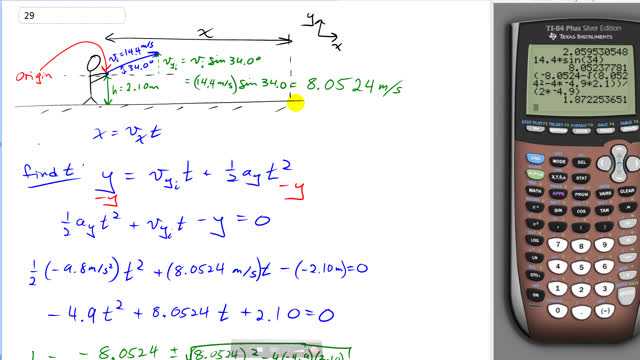
A shot-putter throws the "shot" (mass = 7.3 kg) with an initial speed of 14.4 m/s at a angle to the horizontal. Calculate the horizontal distance traveled by the shot if it leaves the athlete's hand at a height of 2.10 m above the ground.

In order to watch this solution you need to have a subscription.
This is Giancoli Answers with Mr. Dychko. So here's a question where you are asked for the range of this projectile and you cannot use the range formula and the reason for that is that the projectile lands at a height on the ground here which is different from the height that it was launched from so it's called the level range formula and the word level means you can only use it when the projectile lands at the same level— vertical level— as what it was launched from; that's not the case here so we have to do a bit more work. We are going to first use this equation which says the horizontal displacement will be the horizontal component of its velocity multiplied by time and there's no acceleration horizontally so that's it. And we can find the horizontal component of its velocity cos 34 times the initial velocity of 14.4 but the part that we have to do some work to find though is this time; how long does it spend in the air? So let's figure that out first and we know the vertical displacement is gonna be the component of the velocity, that's vertical initially, times time plus one-half vertical acceleration times time squared and we are gonna subtract y from both sides and we are gonna turn this into a quadratic equation so that we can solve for t and we plug in negative 9.8 meters per second squared for the vertical acceleration and we are taking up to be positive and to the right positive and times time squared plus the vertical component of its velocity which is 14.4 times sin 34 which is 8.0524 meters per second and minus the vertical displacement of negative 2.1 so this minus comes from the algebra and then this negative is the fact that it's you know, final position is lower than its initial position; I guess I could show in more detail where that comes from. It's y is y final minus y initial and then y final is zero taking well, I guess I wrote the word origin here didn't I so that would suggest that the initial is zero, any case, y-final then would be negative 2.1 minus the initial y position of zero and then that becomes negative 2.1 or you could have taken the ground to be the zero level, which is typically more common, in which case you would have y-final being zero and y-initial being positive 2.1 and this results in negative 2.1 either way. So there we have it. And then this all gets plugged into the quadratic formula to solve for t and we have negative 8.0524 and we are using minus here using a plus gives you a negative time which is which does have a physical interpretation but you know because it's negative, we are not gonna use it but it would be the time, you know, prior to being launched that it would have been at the ground level had it been a projectile fired from that level. Anyway so we get 1.8723 seconds is the amount of time that it spends in the air so that's what we were looking for to substitute in this equation and we'll plug that in times by 14.4 times cos of 34 degrees and we end up with our answer of about 22.— how many significant figures should we have from that yeah, we should have three significant figures— so 22.4 meters, voila!